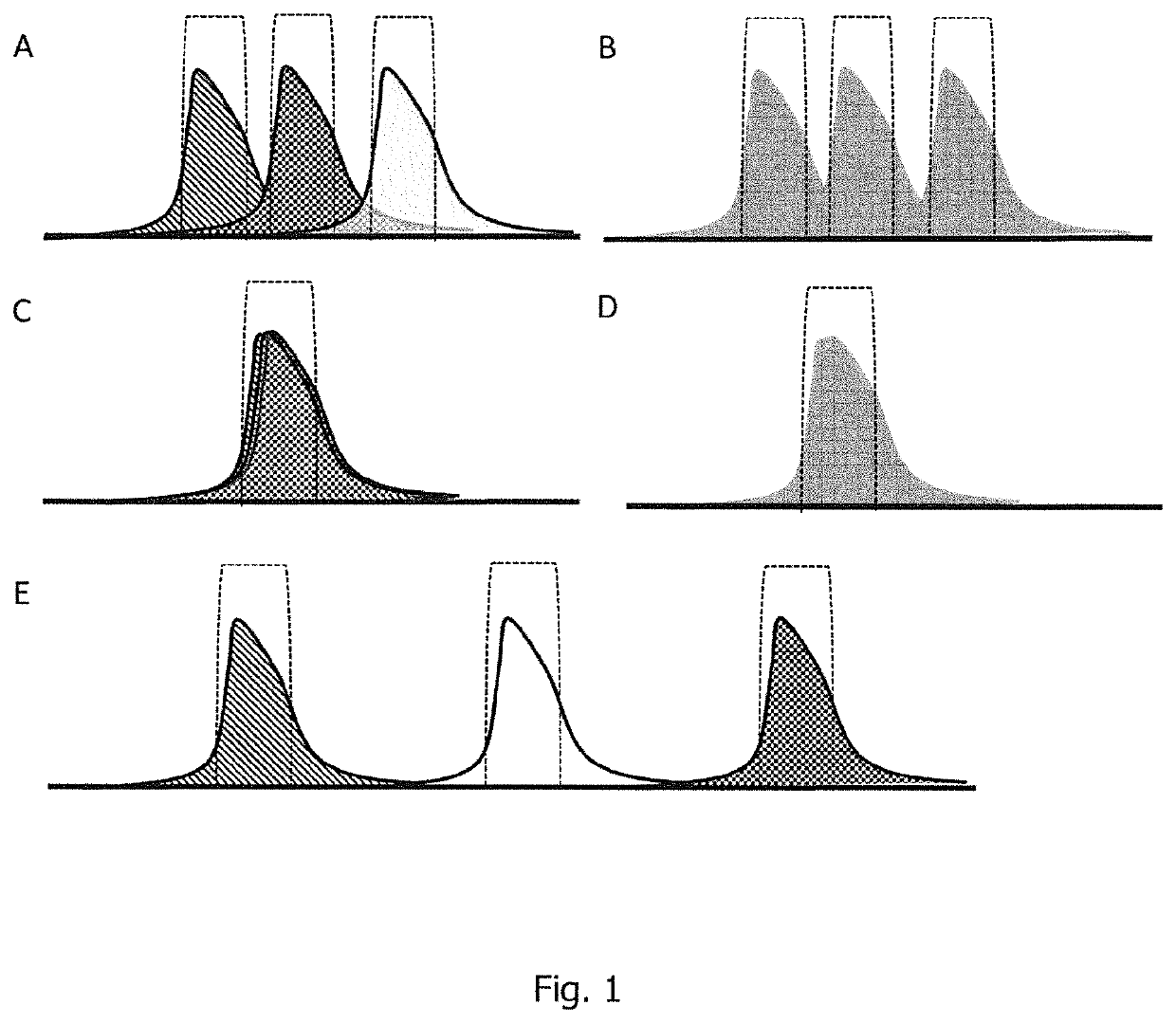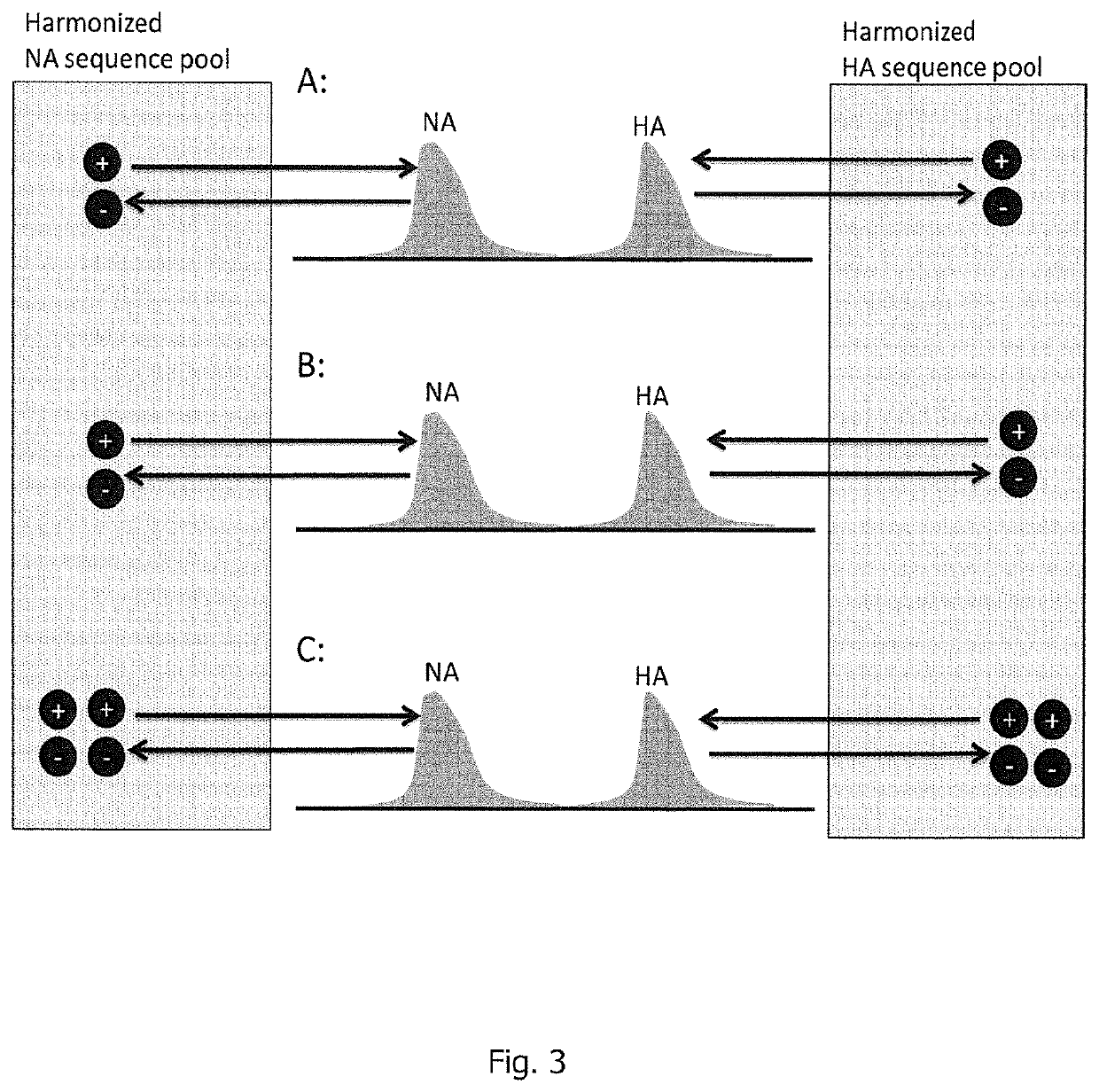RNA sequence adaptation
a technology of rna sequence and rna sequence, which is applied in the field of rna sequence adaptation, can solve the problems of laborious and costly production of rna mixtures containing several rna molecule species, and achieve the effect of increasing strong impact on the retention time of the rna, and increasing the ratio of the number of a nucleotide to the number of u nucleotides
- Summary
- Abstract
- Description
- Claims
- Application Information
AI Technical Summary
Benefits of technology
Problems solved by technology
Method used
Image
Examples
example 1
on of the Correlation Between Homopolymer Stretches of Nucleotides on HPLC Retention Times
[0406]The inventors surprisingly found that not the size of an RNA, but the total number of adenine nucleotides (A nucleotides) and / or uracil nucleotides (U nucleotides) of an RNA is influencing HPLC retention times. Further details are provided in the following.
[0407]1.1. Preparation of DNAs Encoding Firefly Luciferase Including Varying Stretches of Adenines:
[0408]The DNA sequence encoding firefly luciferase protein was introduced into a modified pUC19 derived vector backbone to comprise a 5′-UTR derived from the 32L4 ribosomal protein (32L4 TOP 5′-UTR) and a 3′-UTR derived from albumin, a histone-stem-loop structure, and stretches of varying numbers of adenine nucleotides (also referred to in the following as ‘polyA stretch’ or ‘A homopolymer’) at the 3′-terminal end and. The complete RNA sequences are provided in the sequence listing (see Table 4 below).
TABLE 4Constructs used in the experime...
example 2
tion of HPLC Retention Times of Different HA RNA Sequences for Co-Purification and / or Co-Analysis by Adaptation of the Adenine Count
[0417]The inventors surprisingly found that the adaptation the total number of A nucleotides in two or more different RNA species (e.g. RNA molecules comprising different sequences encoding influenza HA-B) is suitable to harmonize the HPLC retention times, so that co-purification and / or co-analysis becomes feasible. Further details are provided in the following.
[0418]2.1. Adaptation of the Total Number of a Nucleotides:
[0419]As the previous examples show a correlation between the number of A nucleotides in an RNA sequence and the respective HPLC retention time, RNA sequences encoding HA antigens (four different RNA sequences encoding influenza HA) were adapted so that they comprised (essentially) the same number of A nucleotides. The sequence adaptation was performed in such a way that the encoded amino acid sequence was unchanged, either by exploiting ...
example 3
n of Suitability of HPLC for Co-Analysis of RNA Mixture
[0429]The inventors showed that HPLC is a particularly suitable method for co-analysis of an RNA mixture. Further details are provided in the following.
[0430]3.1. Preparation of Test RNA:
[0431]RNA for testing the HPLC system was generated according to Example 1.
[0432]3.2. Directed Degradation of RNA and Preparation of RNA Mixtures of Different Integrities:
[0433]RNA samples were degraded at 90° C. for 140 minutes. Subsequently, intact RNA and degraded RNA were mixed in different ratios of intact RNA: degraded RNA (90:10, 80:20, 70:30, 60:40, 50:50, 40:60, 30:70, 20:80, and 10:90) and respective RNA mixtures of varying integrities were applied to analytic HPLC. Analytic HPLC was performed as described in Example 1. For analysis, HPLC runs of the different RNA mixtures were superimposed. The results are shown in FIG. 7.
[0434]Results:
[0435]As FIG. 7 shows, RNA integrity of an RNA mixture can be determined in a scenario where the RNA...
PUM
| Property | Measurement | Unit |
|---|---|---|
| Time | aaaaa | aaaaa |
| Structure | aaaaa | aaaaa |
| Content | aaaaa | aaaaa |
Abstract
Description
Claims
Application Information
 Login to View More
Login to View More - R&D
- Intellectual Property
- Life Sciences
- Materials
- Tech Scout
- Unparalleled Data Quality
- Higher Quality Content
- 60% Fewer Hallucinations
Browse by: Latest US Patents, China's latest patents, Technical Efficacy Thesaurus, Application Domain, Technology Topic, Popular Technical Reports.
© 2025 PatSnap. All rights reserved.Legal|Privacy policy|Modern Slavery Act Transparency Statement|Sitemap|About US| Contact US: help@patsnap.com



